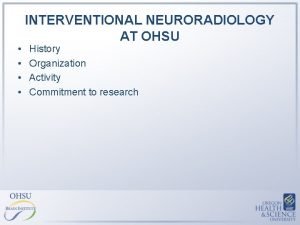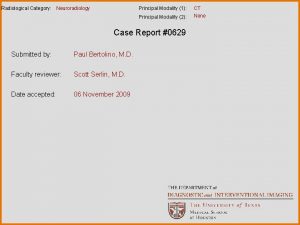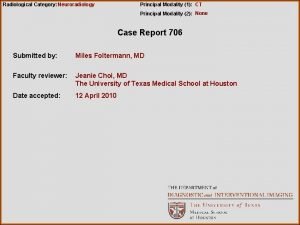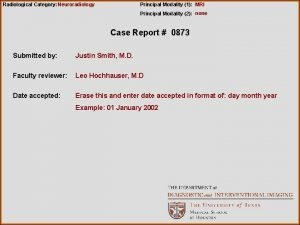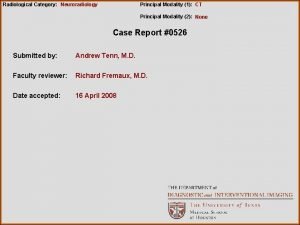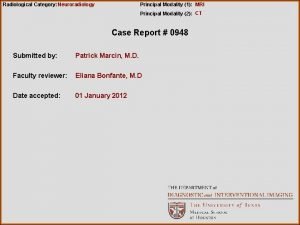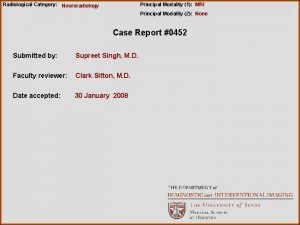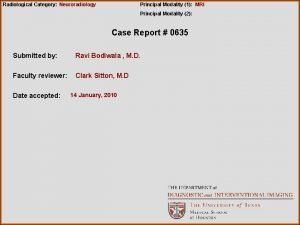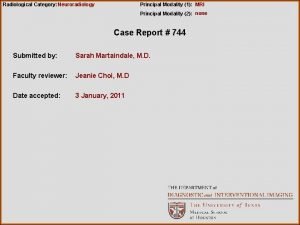Radiological Category Neuroradiology Principal Modality 1 CT Principal










- Slides: 10

Radiological Category: Neuroradiology Principal Modality (1): CT Principal Modality (2): none Case Report # 772 Submitted by: David M. Sada, M. D. Faculty reviewer: Scott Serlin, M. D. , The University of Texas Medical School at Houston Date accepted: 14 February, 2011

Case History 63 year old male with a history of T 3 N 0 M 0 laryngeal cancer, who finished chemoradiation therapy, 3 and a half years ago. He has not had any evidence of disease in the interim, has stable hoarseness, tolerates PO well, and has no signs or symptoms of aspiration. He presents for his regularly scheduled surveillance CT imaging. Physical exam of the oral cavity and throat are unremarkable in clinic visits both before and after CT examinations.

Radiological Presentations

Radiological Presentations

Test Your Diagnosis Which one of the following is your choice for the appropriate diagnosis? After your selection, go to next page. • Metastatic recurrence of laryngeal carcinoma • New primary mucosal malignancy • Intraoral foreign body • Abscess of oral mucosa • Vascular malformation

Findings and Differentials Findings: On contrast enhanced CT of the soft tissues of the neck, a 1. 6 cm well circumscribed, round, soft tissue attenuation mass is identified in the left oral cavity. It is hyperdense with apparent contrast enhancement. The mass is located immediately inferior to the left maxillary alveolar ridge. The mass displaces the tongue but does not appear to involve it. There is no bony involvement. Differentials: • Metastatic recurrence of laryngeal cancer • New primary mucosal malignancy • Intraoral foreign body • Abscess of oral mucosa • Vascular malformation

Discussion The patient reported no symptoms and physical inspection of the oral cavity both before and after the CT examination was unremarkable. If the 1. 6 cm lesion was pathologic, it would almost certainly be detectable on physical exam given its location. The lack of physical findings to accompany the “lesion” seen on CT makes recurrent or primary malignancy or abscess far less likely, and further investigation should be made as to the possibility of an intraoral comestible foreign body. A vasular malformation of that size as well, protruding into the oral cavity would also have been detectable on physical exam. Upon further questioning, the patient admitted to having chewing gum in his mouth at the time of the CT, which he tucked in the upper left of his mouth during scanning.

Discussion Intraoral chewing gum often has a typical appearance on CT intraorally. It is typically round or ovoid. Frequently it is found between the teeth and buccal mucosa or between the tongue and hard palate. Small locules of low density are frequently seen as well, caused by small bubbles within the gum. This is seen in our patient in the most inferior aspect of the wad of gum. Chewing gum also has an inherent high density caused by its composition, which varies from brand to brand, but typically remains high. This can often be confused with contrast enhancement of soft tissue. The malleable nature of gum, and its ability to contour to adjacent surfaces, along with its high density simulating contrast enhacement can cause potential for misdiagnosis as malignancy, enhancing lymph node, vascular malformation, or sialolithiasis. As a result, screenign for intraoral foreign bodies should be considered prior to imaging.

Diagnosis Intraoral foreign body (chewing gum. )

References Towbin AJ. The CT Appearance of Intraoral Chewing Gum. Pediatr Radiol (2008) 38: 1350 -1352. Mc. Dermott M, Branstetter BF, Escott EJ. What’s in Your Mouth? The CT Appearance of Comestible Intraoral Foreign Bodies. Am J Neuroradiol Sep 2008 29: 1552 -55
 Ohsu neuroradiology
Ohsu neuroradiology Erate category 2
Erate category 2 Radiological dispersal device
Radiological dispersal device Tennessee division of radiological health
Tennessee division of radiological health Center for devices and radiological health
Center for devices and radiological health National radiological emergency preparedness conference
National radiological emergency preparedness conference Sodality vs modality
Sodality vs modality One to many relationship line
One to many relationship line Epistemic modality
Epistemic modality Modality erd
Modality erd Modality in software engineering
Modality in software engineering
